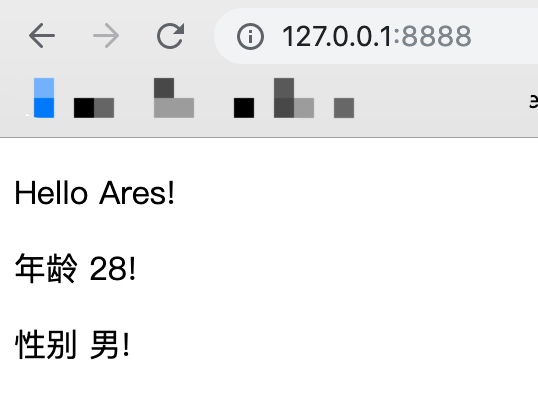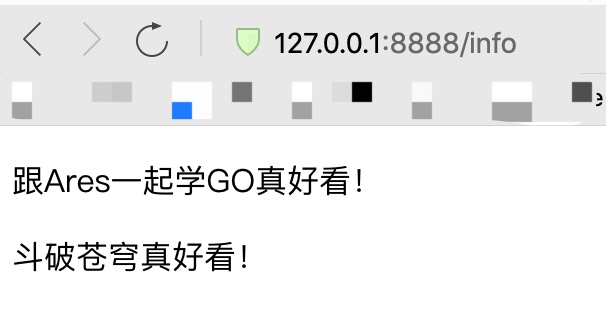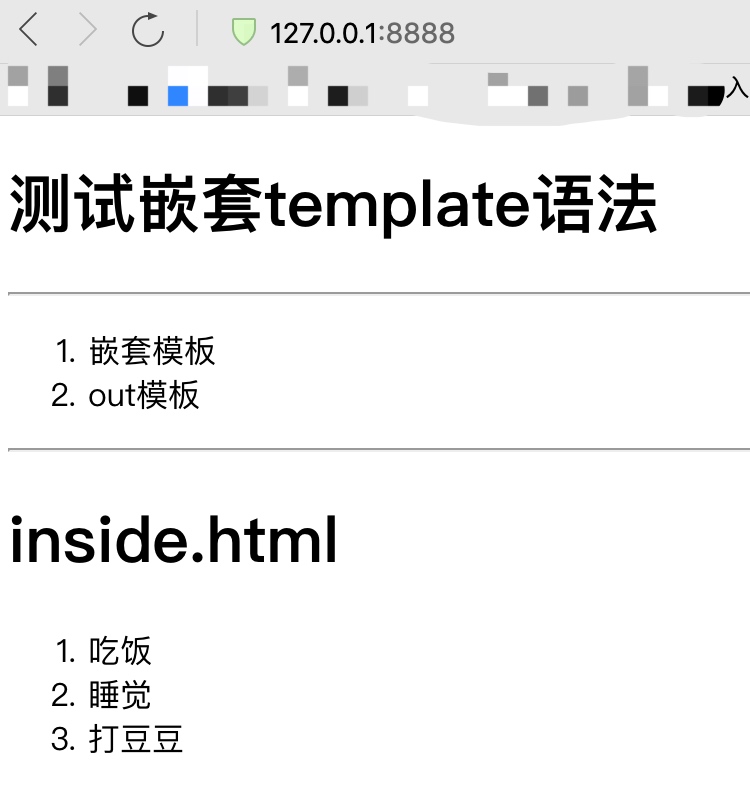模板
一个模板是一个字符串或一个文件,里面包含了一个或多个由双花括号包含的{{action}}对象。大部分的字符串只是按面值打印,但是对于actions部分将触发其它的行为。每个actions都包含了一个用模板语言书写的表达式,一个action虽然简短但是可以输出复杂的打印值,模板语言包含通过选择结构体的成员、调用函数或方法、表达式控制流if-else 语句range循环语句,还有其它实例化模板等诸多特性。Action内部不能有换行,但注释可以有换行。
示例
模板执行时会遍历结构并将指针表示为’.‘(称之为”dot”)指向运行过程中数据结构的当前位置的值。
用作模板的输入文本必须是utf-8编码的文本。
Html示例:
<!DOCTYPE html>
<html lang="en">
<head>
<meta charset="UTF-8">
<title>Hello</title>
</head>
<body>
<p>Hello {{.}}!</p>
</body>
</html>
GO server端:
func sayHi(w http.ResponseWriter,r *http.Request) { // 解析指定文件生成模板对象 tem,err := template.ParseFiles("xx/hello.html") if err != nil{ fmt.Println("读取文件失败,err",err) return } // 利用给定数据渲染模板,并将结果写入w tem.Execute(w,"Ares") } func main() { http.HandleFunc("/",sayHi) err := http.ListenAndServe("127.0.0.1:8888",nil) if err != nil{ fmt.Println("监听失败,err",err) return } } 效果: 

模板语法
模板语法都包含在{{和}}中间,其中{{.}}中的点表示当前对象。
当我们传入一个结构体对象时,我们可以根据.来访问结构体的对应字段。Html示例:
<html lang="en">
<head>
<meta charset="UTF-8">
<title>Hello</title>
</head>
<body>
<p>Hello {{.Name}}!</p>
<p>年龄 {{.Age}}!</p>
<p>性别 {{.Male}}!</p>
</body>
</html>
GO server端:
type People struct {
Name string
Age int
Male string } func sayHi(w http.ResponseWriter,r *http.Request) { // 解析指定文件生成模板对象 tem,err := template.ParseFiles("xx/hello.html") if err != nil{ fmt.Println("读取文件失败,err",err) return } // 利用给定数据渲染模板,并将结果写入w People := People{ Name:"Ares", Age:28, Male:"男", } tem.Execute(w,People) } func main() { http.HandleFunc("/",sayHi) err := http.ListenAndServe("127.0.0.1:8888",nil) if err != nil{ fmt.Println("监听失败,err",err) return } } 效果: 

注释
{{/* a comment */}}
可以多行。注释不能嵌套。
变量
Action里可以初始化一个变量来捕获管道的执行结果。初始化语法如下:
$variable := pipeline
示例:
<body>
<p>Hello {{.Name}}!</p>
<p>年龄 {{.Age}}!</p>
<p>性别 {{.Male}}!</p>
{{ $age := . }}
{{ $age.Age }}
</body>
条件判断
初始语法:
{{if pipeline}} T1 {{end}}
{{if pipeline}} T1 {{else}} T0 {{end}}
{{if pipeline}} T1 {{else if pipeline}} T0 {{end}} 示例:
<body>
<p>Hello {{.Name}}!</p>
<p>年龄 {{.Age}}!</p>
<p>性别 {{.Male}}!</p>
{{ $age := . }}
{{ $age.Age }}
{{if gt .Age 18}}
<div>成年啦!</div>
{{else}}
<div>快乐成长!</div>
{{end}}
</body>
比较函数
布尔函数会将任何类型的零值视为假,其余视为真。
eq 如果arg1 == arg2则返回真
ne 如果arg1 != arg2则返回真
lt 如果arg1 < arg2则返回真
le 如果arg1 <= arg2则返回真
gt 如果arg1 > arg2则返回真
ge 如果arg1 >= arg2则返回真
range
使用range关键字进行遍历,有以下两种写法,其中pipeline的值必须是数组、切片、字典或者通道。
基本语法:
{{range pipeline}} T1 {{end}}
如果pipeline的值其长度为0,不会有任何输出
{{range pipeline}} T1 {{else}} T0 {{end}}
如果pipeline的值其长度为0,则会执行T0。 map示例:
PeopleMap := map[int]People{
1: {"Ares", 18, "男"}, 2: {"龙猫", 28, "女"}, } tem.Execute(w, PeopleMap) 切片示例:
PeopleSlice := []People{
{"Ares", 18, "男"},
{"龙猫", 28, "女"}, } tem.Execute(w, PeopleSlice) HTML模板:
<body>
<table border="1">
<thead>
<tr>
<th>序号</th>
<th>姓名</th>
<th>年龄</th>
<th>性别</th>
</tr>
</thead>
<tbody>
{{range $index, $user := .}}
<tr>
<td>{{$index}}</td>
<td>{{$user.Name}}</td>
<td>{{$user.Age}}</td>
<td>{{$user.Male}}</td>
</tr>
{{end}}
</tbody>
</table>
</body>
效果: 

预定义函数
执行模板时,函数从两个函数字典中查找:首先是模板函数字典,然后是全局函数字典。一般不在模板内定义函数,而是使用Funcs方法添加函数到模板里。
and
函数返回它的第一个empty参数或者最后一个参数;
就是说"and x y"等价于"if x then y else x";所有参数都会执行; or 返回第一个非empty参数或者最后一个参数; 亦即"or x y"等价于"if x then x else y";所有参数都会执行; not 返回它的单个参数的布尔值的否定 len 返回它的参数的整数类型长度 index 执行结果为第一个参数以剩下的参数为索引/键指向的值; 如"index x 1 2 3"返回x[1][2][3]的值;每个被索引的主体必须是数组、切片或者字典。 print 即fmt.Sprint printf 即fmt.Sprintf println 即fmt.Sprintln html 返回其参数文本表示的HTML逸码等价表示。 urlquery 返回其参数文本表示的可嵌入URL查询的逸码等价表示。 js 返回其参数文本表示的JavaScript逸码等价表示。 call 执行结果是调用第一个参数的返回值,该参数必须是函数类型,其余参数作为调用该函数的参数; 如"call .X.Y 1 2"等价于go语言里的dot.X.Y(1, 2); 其中Y是函数类型的字段或者字典的值,或者其他类似情况; call的第一个参数的执行结果必须是函数类型的值(和预定义函数如print明显不同); 该函数类型值必须有1到2个返回值,如果有2个则后一个必须是error接口类型; 如果有2个返回值的方法返回的error非nil,模板执行会中断并返回给调用模板执行者该错误; 参考:GO语言标准库
示例:
<p>{{index . 1}}</p>
<p>切片长度: {{len .}}</p>
<p>
{{with index . 1}}
{{printf "姓名:%s 年龄:%d 性别:%s" .Name .Age .Male}}
{{end}}
</p>
效果: 

自定义函数
自定义一个book函数:
type Book struct {
Name string
Author string
Price float32 } func info(w http.ResponseWriter,r *http.Request) { // 打开一个模板文件 htmlByte,err := ioutil.ReadFile("./info.html") if err != nil{ fmt.Println("读取html文件失败,err",err) return } // 1. 自定义一个函数 // 自定义一个书籍的模板函数 bookFunc := func(arg string) (string, error) { return arg + "真好看!", nil } // 2. 把自定义的函数告诉模板系统 // template.New("info") // 创建一个Template对象 // template.New("info").Funcs(template.FuncMap{"book": bookFunc}) // 给模板系统追加自定义函数 // 解析模板 t,err := template.New("info").Funcs(template.FuncMap{"book": bookFunc}).Parse(string(htmlByte)) if err != nil{ fmt.Println("parse html文件失败,err",err) return } BookMap := map[int]Book{ 1:{"跟Ares一起学GO","Ares",9.9}, 2:{"斗破苍穹","Ares1",99.9}, } t.Execute(w,BookMap) } func main() { http.HandleFunc("/info",info) http.ListenAndServe("127.0.0.1:8888",nil) } html:
<body>
<p>
{{with index . 1}}
<p>{{book .Name}}</p>
{{end}}
</p>
<p>
{{with index . 2}}
<p>{{book .Name}}</p>
{{end}}
</p>
</body>
效果: 

模板嵌套
我们可以在template中嵌套其他的template。这个template可以是单独的文件,也可以是通过define定义的template.
func index(w http.ResponseWriter,r * http.Request) { t , err := template.ParseFiles("./index.html","./test.html") if err != nil{ fmt.Println("读取html文件失败,err",err) return } t.Execute(w,nil) } func main() { http.HandleFunc("/",index) http.ListenAndServe("127.0.0.1:8888",nil) } index.html:
<body>
<h1>测试嵌套template语法</h1>
<hr>
{{template "test.html"}}
<hr>
{{/* 在index.html这个模板中调用了另外一个模板:index.html */}}
{{template "inside.html"}}
</body>
</html>
{{/* 在index.html这个模板中定义了另外一个模板:inside.html */}}
{{ define "inside.html"}} <h1>inside.html</h1> <ol> <li>吃饭</li> <li>睡觉</li> <li>打豆豆</li> </ol> {{end}} test.html:
<body>
<ol>
<li>嵌套模板</li>
<li>out模板</li>
</ol>
</body>
效果: